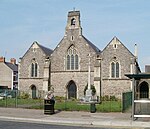RAF Pengam Moors
Royal Air Force Pengam Moors or more simply RAF Pengham Moors is a former Royal Air Force station and maintenance unit (MU), located on the Pengam Moors area of Tremorfa, 2 miles south east of Cardiff city centre in Wales from June 1938 to January 1946. It was also known as RAF Cardiff) Prior to RAF service the site served as a private aerodrome later called Cardiff Municipal Airport. After the Second World War the airfield reverted to private commercial flying until closure in 1954 when all services were transferred to the larger Rhoose Airport. The runway has since been removed and the site has been covered with industrial units, private housing and a school, with the names of many roads reflecting the previous history as an airfield.
Excerpt from the Wikipedia article RAF Pengam Moors (License: CC BY-SA 3.0, Authors).RAF Pengam Moors
Hind Close, Cardiff Pengam Green
Geographical coordinates (GPS) Address Nearby Places Show on map
Geographical coordinates (GPS)
| Latitude | Longitude |
|---|---|
| N 51.485555555556 ° | E -3.1322222222222 ° |
Address
Hind Close
Hind Close
CF24 2EF Cardiff, Pengam Green
Wales, United Kingdom
Open on Google Maps







